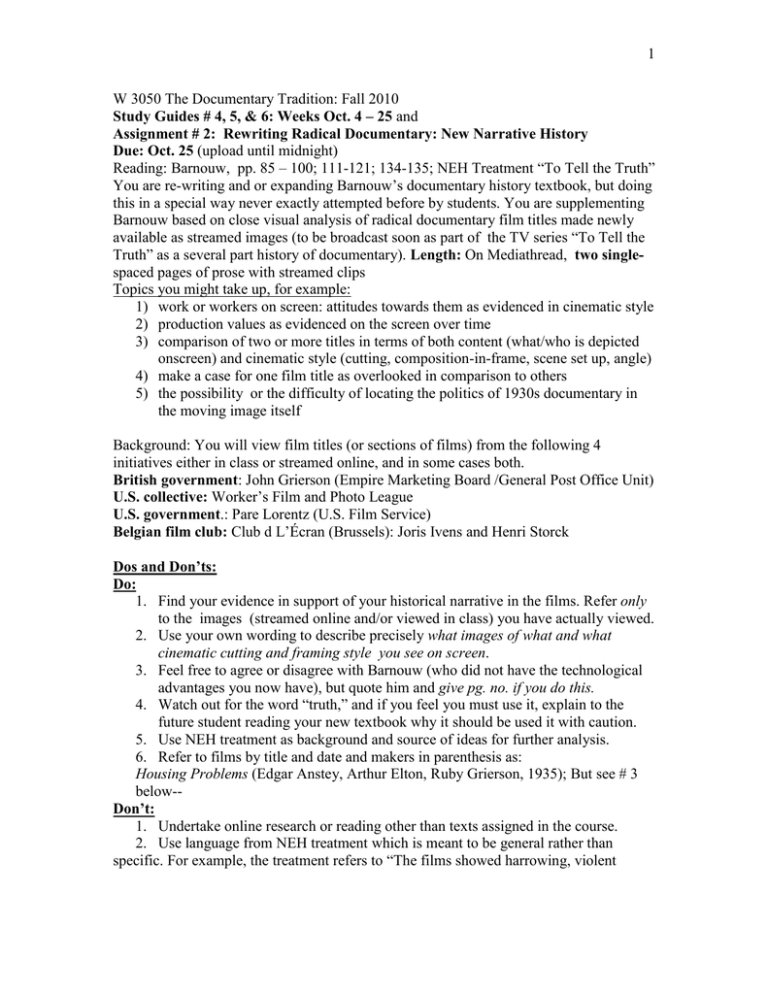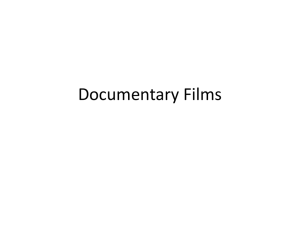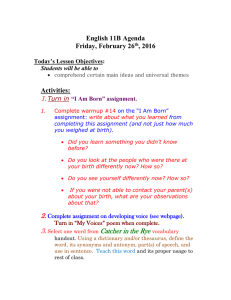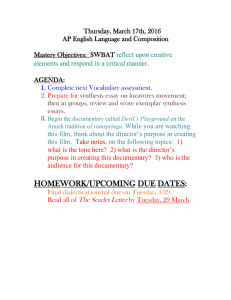1 W 3050 The Documentary Tradition: Fall 2010
advertisement

1 W 3050 The Documentary Tradition: Fall 2010 Study Guides # 4, 5, & 6: Weeks Oct. 4 – 25 and Assignment # 2: Rewriting Radical Documentary: New Narrative History Due: Oct. 25 (upload until midnight) Reading: Barnouw, pp. 85 – 100; 111-121; 134-135; NEH Treatment “To Tell the Truth” You are re-writing and or expanding Barnouw’s documentary history textbook, but doing this in a special way never exactly attempted before by students. You are supplementing Barnouw based on close visual analysis of radical documentary film titles made newly available as streamed images (to be broadcast soon as part of the TV series “To Tell the Truth” as a several part history of documentary). Length: On Mediathread, two singlespaced pages of prose with streamed clips Topics you might take up, for example: 1) work or workers on screen: attitudes towards them as evidenced in cinematic style 2) production values as evidenced on the screen over time 3) comparison of two or more titles in terms of both content (what/who is depicted onscreen) and cinematic style (cutting, composition-in-frame, scene set up, angle) 4) make a case for one film title as overlooked in comparison to others 5) the possibility or the difficulty of locating the politics of 1930s documentary in the moving image itself Background: You will view film titles (or sections of films) from the following 4 initiatives either in class or streamed online, and in some cases both. British government: John Grierson (Empire Marketing Board /General Post Office Unit) U.S. collective: Worker’s Film and Photo League U.S. government.: Pare Lorentz (U.S. Film Service) Belgian film club: Club d L’Écran (Brussels): Joris Ivens and Henri Storck Dos and Don’ts: Do: 1. Find your evidence in support of your historical narrative in the films. Refer only to the images (streamed online and/or viewed in class) you have actually viewed. 2. Use your own wording to describe precisely what images of what and what cinematic cutting and framing style you see on screen. 3. Feel free to agree or disagree with Barnouw (who did not have the technological advantages you now have), but quote him and give pg. no. if you do this. 4. Watch out for the word “truth,” and if you feel you must use it, explain to the future student reading your new textbook why it should be used it with caution. 5. Use NEH treatment as background and source of ideas for further analysis. 6. Refer to films by title and date and makers in parenthesis as: Housing Problems (Edgar Anstey, Arthur Elton, Ruby Grierson, 1935); But see # 3 below-Don’t: 1. Undertake online research or reading other than texts assigned in the course. 2. Use language from NEH treatment which is meant to be general rather than specific. For example, the treatment refers to “The films showed harrowing, violent 2 images of police suppressing protest rallies with guns, clubs and tear gas.” This is a composite of several films, not a specific scene in a film. 3. Credit every image choice to a filmmaker since hard evidence of “who did what” is difficult to determine for historical productions. Refer instead to “the film.” As “the film focuses in medium shot on” or “the film cuts to.” First choice titles to study: Drifters (prod. John Grierson, 1929); Coal Face (Alberto Cavalcanti, 1936); Night Mail (Basil Wright, Harry Watt, 1936); Hands (Ralph Steiner, Williard Van Dyke, 1934); Housing Problems (Edgar Anstey, Arthur Elton, Ruby Grierson, 1935); Industrial Britain (Robert Flaherty, John Grierson, 1933); The Plow That Broke the Plains (Pare Lorentz, 1936); The River (Pare Lorentz, 1937); Unemployment Special 1931, Detroit Workers, Ford Massacre, Hunger, National Hunger March to Washington 1932 , Bonus March 1932 (Workers’ Film and Photo League, 1932); Misery in the Borinage (Joris Ivens and Henri Storck, 1933); Enough to Eat (Edgar Anstey, 1936) 2nd choice titles: America Today (WFPL); Contact (Rotha); The City (Steiner, Van Dyke); The World Today (WFPL); March of Time (Rochemont); The Land (Flaherty); Spanish Earth (Ivens); People of the Cumberland (Frontier Films); Native Land (Frontier Films); Land Without Bread (Bunuel) Week # 4: October 4: Study Guide Reading: Bruzzi, 11 – 21 Questions: 1. Why does the Zapruder footage not offer us the perfect example of unbiased documentary? 2. What are the limitations of the Zapruder footage as historical evidence? List. 3. How is it possible for documentary footage to be both “unimpeachable” and “open to interpretations”? Reading: Barnouw, Ch. 1 Questions: Review from Week 1 1. How did the experiments of Muybridge, Marey, and Demeny provide “intimations” of things documentary film might do? List. 2. What features of the Lumiere camera made it especially suited to documentary work, and how did it differ from the Edison Co. set up? 3. What does the term “authentic reconstitution” tell us about both audiences and entrepreneurs who “faked” historical events around 1900? 4. What reasons does Barnouw give for the decline of the actualitie and what better explanations would you offer? Week # 5: October 11: Study Guide Reading: Winston, “The Tradition of the Victim” 1. Explain the Griersonian prohibition against characterization. Where did it come from? 2. What would be the filmmakers objection to slum dwellers making their own film in the approach to Housing Problems (1935)? 3. In what ways did new technologies contribute to the tradition of the victim as the subject of documentary? Which do you think was the most important in this regard? 3 4. What does Winston’s raising the question of filmmaker complicity have do to the question of documentary ethics? 5. Winston, a former lawyer, dismisses the “right to privacy” as legal recourse for subjects of documentary. Why? Reading: Lerner, “Damming Virgil Thomson’s Music for The River” 1.What is so paradoxical about the principle of “inaudibility” and why do you think this principle persists? 2. How is the score of The River (1937) like a river according to Lerner? 3. What are the challenges of attempting an “American musical idiom” using both “borrowed” and composed music? 4. How does Lerner demonstrate through a reading of the musical “subtext” that the score is directed toward one population segment to the exclusion of others and how should we take Thomson’s denial that his score achieved this ? 5. A musical score could be said to confirm, contradict, or ambiguate the image track. What is the best example you find from the article on the way the score works in any one of these three ways? Week # 6: October 18 Study Guide Reading: Nichols, Ch. 1 1. How is Nichols able to say that documentary makes an argument in later chapters and in this one say that some films convey truths “if we decide they do”? 2. What does Nichols think is fictional about Nanook of the North (1921)? List. 3. Documentary is unlike fiction in that it can have effects on its subjects. Answer all of the questions Nichols raises on p. 6, middle paragraph. 4. What is the difference between “them” and “you” as documentary addresses. Compare. 5. “I speak about them to you.” Explain why this is the most common documentary formulation of the maker-subject-audience relation. Reading: Williams, “The Ethics of Intervention” 1.Why does the author think the category of complicit participation does not fit in the 6 categories of “gazes” derived from Bill Nichols and Vivian Sobchack? 2. What is your answer to the question, “Can a First World filmmaker who portrays himself as a man who buys the sexual favors of a woman do anything ‘good’ for her?” and on what does your answer depend? 3. A parallel is drawn here between making this documentary and the relations of prostitution. What are the ways in which these relations are similar and dissimilar? 4. What is the problem with any attempt to grasp the “truth” of the Bangkok prostitute’s life? 5. What is meant by the “vulnerability” of The Good Woman of Bangkok to feminist criticism? How valid is this criticism and upon what premises is it based? 6. Compare O’Rourke’s situation to that of photographer Kevin Carter who faced the subject of the starving girl and the vulture. How are the ethical dilemmas they face different or the same?




